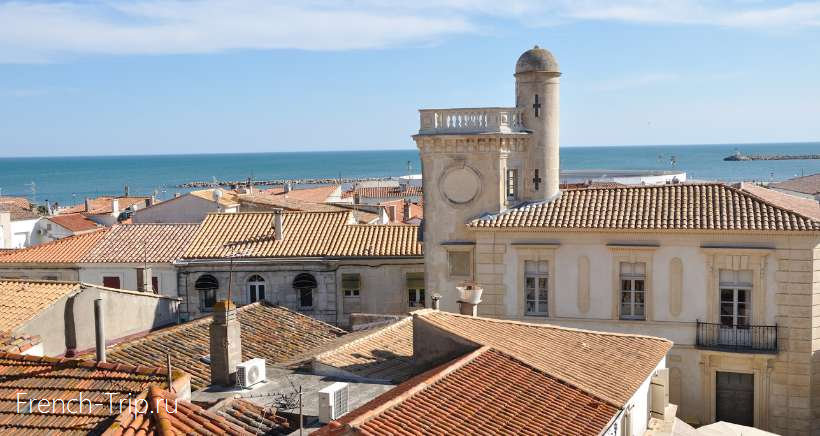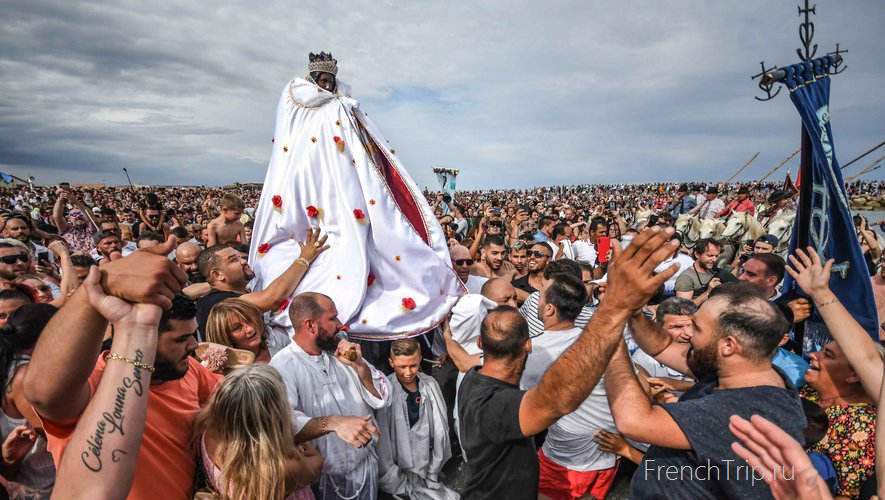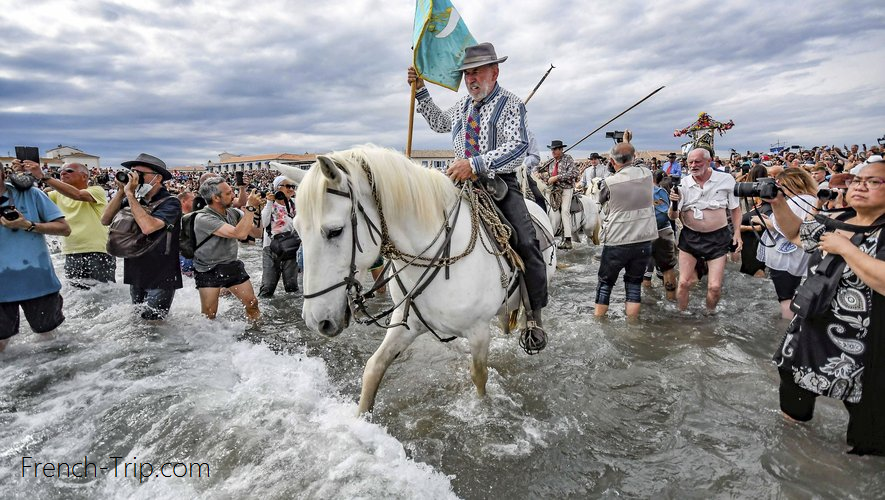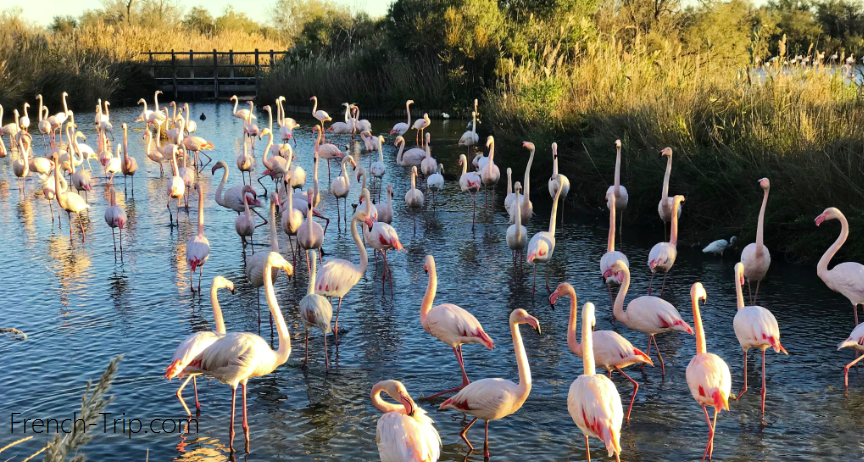Main sights of Saintes-Maries-de-la-Mer

Saintes-Maries-de-la-Mer is known for its cultural diversity, influenced by the various communities that have settled here over the centuries. It’s a place where the traditions of Provence meet the Romani culture. The town is particularly famous for its festivals celebrating the Romani people, such as the Gypsy Pilgrimage in May.
You can also use Walking Tour of Saintes-Maries-de-la-Mer to observe all mains sights of this town in just one comfortable walk.
Sights of Saintes-Maries-de-la-Mer
Explore the town’s historical sites, including the fortified church of Notre-Dame-de-la-Mer, which houses the relics of Saint Sarah, the patron saint of the Romani people.
Église fortifiée Saintes-Maries-de-la-Mer
In the Notre-Dame-de-la-Mer Cathedral, built in the 11th century, the relics of Saint Mary, the sister of the Virgin Mary and mother of the apostles James and John the Evangelist, as well as those of Mary Magdalene, are preserved. In the underground crypt of the cathedral, the relics of Saint Sarah (Sent Sara), the patron saint of the Roma people, are located. Her feast day is celebrated on May 25th. On this day, many Roma communities gather in Saintes-Maries-de-la-Mer in the south of France to pay homage to their patron saint.
In 1798, after the French Revolution, the Notre-Dame-de-la-Mer Cathedral was destroyed and only rebuilt in 1873. Since then, Saintes-Maries-de-la-Mer has attracted many pilgrims who come to venerate these sacred Christian relics.
The Legend of Saint Sarah
Sarah was a servant of Mary Cleopas, the aunt of Jesus, and Mary Salome, the mother of two apostles. Legend has it that they, along with Mary Magdalene and other New Testament figures, were expelled from Palestine by the Jews and set adrift on a boat without sails or oars.
Winds and currents brought the boat to an island at the mouth of the Rhône River, where the locals worshiped the Egyptian god Ra. Mary Cleopas, Mary Salome, and Sarah, who was Egyptian, stayed here to preach, while the others who arrived went to different parts of Provence. Their relics were “discovered” in the fortified church of Saintes-Maries-de-la-Mer on a former island in 1448, around the time when the Roma migrated to Western Europe from the Balkans and Spain.

The Roma began making pilgrimages to Saintes-Maries-de-la-Mer no later than the 16th century. Their pilgrimage days coincide with weddings and baptisms, filled with music, dance, and passionate religious rituals. After the mass on May 24th, the statues of the saints are brought down from the upper chapel to the altar, where the faithful reach out to touch them.
The next day, statues of both Marys, accompanied by guardians dressed in full Camargue cowboy attire, residents of Arles in national costumes, and spectators, follow the same path in a wooden boat. From a fishing boat, a bishop blesses the sea, the Camargue, the pilgrims, and the Roma, after which the entire procession returns to the church. In the latter part of the day, the statues are once again raised to their chapel.

Architecture of the Church:
The church itself is characterized by elegant lines and remarkable acoustics. During the Saracen invasions, it served as a refuge for the inhabitants of the surrounding villages and even had its own well with drinking water. The church’s bell tower, which offers the best view of the Camargue, is open for visits from March to October.
Arènes des Saintes-Maries-de-la-Mer
The bullfighting arena in Saintes-Maries-de-la-Mer was solemnly opened in 1931. It can accommodate up to 4,300 people.
Part of the arena collapsed in the same year it opened, so the inauguration had to be repeated in 1932. In 1985, the architect André Marchetti redesigned the arena. Despite its relatively young age, plans for its opening were made at least 100 years before its construction. Each village in the region traditionally had a bullfighting arena somewhere in the center. The arena in Saintes-Maries was designated a historical monument. The arena’s architecture resembles that of a medieval castle keep, reflecting its historical role as a place of refuge during times of pirate and Saracen raids.
Bullfighting traditions have been strong in the region since the 16th century. In some cases, references to bullfights date back to the 12th century. There are three types of bullfights:
- Course Camarguaise: A bloodless (for the bulls) competition where the goal is to remove a ribbon (cocarde) from the bull’s head. Participants, called “raseteurs,” begin training from an early age, competing with bulls from the Camargue.
- Traditional Spanish Corrida (La Course Espagnole): A deadly form of bullfighting where the bull is killed with a sword after being stabbed with banderillas.
- Corrida de Rejón: A mounted bullfight.
Musée Baroncelli
A few steps south of the church, on Victor Hugo Street, you’ll find the Baroncelli Museum (Musée Baroncelli).
Please note that the museum’s opening hours vary, so it’s advisable to check with the tourist office.
Marquis Folco Baroncelli (1869–1943) is a symbolic figure for the Camargue. As the director of a magazine dedicated to provincial poetry called “l’Aïoli” in Avignon, the Marquis was a staunch defender of customs, ecology, traditions, and cultural heritage in the Camargue. He lived like a cowboy and fought for tolerance. Thanks to his efforts, the church authorities recognized the Roma pilgrimage with the statue of Saint Sarah.
The museum’s exhibits reflect this event and other Camargue traditions, as well as presenting its fauna and flora. All parts of the collection were assembled in 1942 by a group of local curators.
The museum is located in the former town hall, which also served as a court, built in 1876 by Veran, an architect from Arles. This building replaced the previous town hall dating back to 1655. From the first building, only marble medallions with the coats of arms of France and Navarre partially designed by the artist Pierre Sibren of Lyon in the 17th century, and partially by local craftsmen, have survived.
On the balcony above the main entrance, you can see three colors:
- Red and white, representing Baroncelli.
- The flag of Provence (red and yellow).
- The House of Anjou (blue with fleur-de-lis and a lambel).
- 25 Rue Victor Hugo, 13460 Saintes-Maries-de-la-Mer
- The entrance fee is €1.50.
Musée des Saintes-Maries-de-la-Mer
Founded in 1936, it was in 1942 that the Camargue Museum (Museon Camarguen) was inaugurated in the former town hall of Les Saintes-Maries-de-la-Mer. It then housed collections related to the heritage of the Camargue and the village, gathered by local tradition enthusiasts, under the watchful eye of Marquis Folco de Baroncelli. Leading the Félibrige newspaper “L’Aïoli” in Avignon, where his family owned the Palais du Roure, Marquis de Baroncelli was a fervent advocate of the customs and traditional cultural heritage of the Camargue. Félibres and residents of Saintes-Maries contributed donations and created an eclectic collection of taxidermied Camargue birds, engravings, paintings, furniture, and various objects.
In 1945, the Camargue Museum became the Baroncelli Museum in homage to the marquis who had died two years earlier. His collection is enriched with documents linked to his personality and objects of local ethnography.
Since 2003 the collections of the Baroncelli Museum have been classified as “Museum of France”.
In 2022: In response to the municipality’s desire to highlight its collections related to Marquis de Baroncelli, as well as its maritime history dating back to ancient times, a new structure was built: The Museum of Saintes-Maries-de-la-Mer. Thus, the Museum of Saintes-Maries-de-la-Mer will inherit the former collections of the now-closed Baroncelli Museum and will also present a comprehensive exhibition dedicated to underwater archaeology and the maritime heritage of the Camargue coastline from ancient times to the modern and contemporary eras.
- Opening hours:
- from July 1 to August 31: every day from 10 a.m. to 12:30 p.m. and from 1:30 p.m. to 6 p.m.
- from September 1 to September 30: Wednesday to Sunday from 10 a.m. to 12:30 p.m. and from 1:30 p.m. to 6 p.m.
- from October 1 to June 30: Wednesday to Sunday from 10 a.m. to 12:30 p.m. and from 1:30 p.m. to 5 p.m.
- Closed on December 25, January 1 and May 1.
- Tickets:
- Full price: €7
- Reduced price: €4
- Reduced for children aged 6 to 17, students under 26 (on presentation of proof), companions of disabled people
- Family price: €16 (2 adults + 1 to 3 young people between 6 and 17 years old)
- Free: Resident of Saintes-Maries-de-la-Mer, child under 6 years old, job seeker, RSA beneficiary, person with a disability, ICOM, tour guide (upon presentation of proof), Days of Heritage, Museum Night, European Archeology Days
- Address: avenue Théodore Aubanel
13460 les Saintes-Maries-de-la-Mer
Statue de Mireille
This statue is dedicated to the literary character Mireille, who is the heroine of the famous poem “Mireio” written by Frédéric Mistral, a Provençal writer and Nobel laureate in literature. The statue pays homage to this iconic character from Provençal literature and is located in the town as a cultural and historical symbol.
Mireille, the character, represents the beauty and virtues of the Provençal culture and is an important figure in the literary heritage of the region. The statue serves as a reminder of Mistral’s contribution to the preservation and celebration of Provençal language and culture.
Visitors to Saintes-Maries-de-la-Mer can admire this statue and learn about the cultural significance of Mireille in the local context. It’s a part of the town’s cultural heritage and adds to the overall charm and character of the place.
- Place Mireille
Camargue
Camargue is a marshy region in the delta of the Rhône River, home to several nature reserves with a total area of 930 square kilometers. The local landscape comprises salt flats, reed marshes, coastal lagoons, and sandy barrier islands.
Camargue is divided by the two branches of the Rhône River into three main parts:
- Petite Camargue: Located to the west of the Petit Rhône (Little Rhône).
- Plan du Bourg: Found to the east of the Grand Rhône (Big Rhône).
- Grand Camargue: This part is predominantly occupied by the lagoon.
The Camargue National Park is the most popular regional natural park in France today and a favorite destination for tourists with children.
Within the park’s territory, there are over a hundred species of mammals, many of which are considered endangered. Rare plant species, including juniper bushes that can reach up to 7 meters in height, also grow here. However, despite such biodiversity, the iconic inhabitants of Camargue are and remain the black bulls, pink flamingos, and wild white horses, which are not found anywhere else in Europe.
To learn more about how to explore Camargue and the cost of excursions, you can refer to the Park Camargue page.
Pont de Gau Ornithological Park
In the vicinity of Saintes-Maries-de-la-Mer, the main attraction is the Pont de Gau Ornithological Park, an enormous nature reserve and sanctuary for numerous bird species that can be observed in their natural habitat. Here, you can spot 260 bird species, some of which are permanent residents, while others migrate depending on the season. The conservation of certain bird species in this park is recognized as a matter of national importance.
For tourists, the park has established a route with observation huts, and informational signs provide insights into the park’s avian inhabitants.
- Admission: €7.5.
- Opening hours: 9 AM to 7 PM during the summer.

Main sights of Saintes-Maries-de-la-Mer on the tourist map:
Map will help you to navigate through the town and find all main attractions of Saint-Marie-de-la-Mer. You can also you Walking tour in Saint-Marie-de-la-Mer with interactive map.
Archives
Calendar
| M | T | W | T | F | S | S |
|---|---|---|---|---|---|---|
| 1 | 2 | 3 | 4 | 5 | 6 | 7 |
| 8 | 9 | 10 | 11 | 12 | 13 | 14 |
| 15 | 16 | 17 | 18 | 19 | 20 | 21 |
| 22 | 23 | 24 | 25 | 26 | 27 | 28 |
| 29 | 30 | 31 | ||||